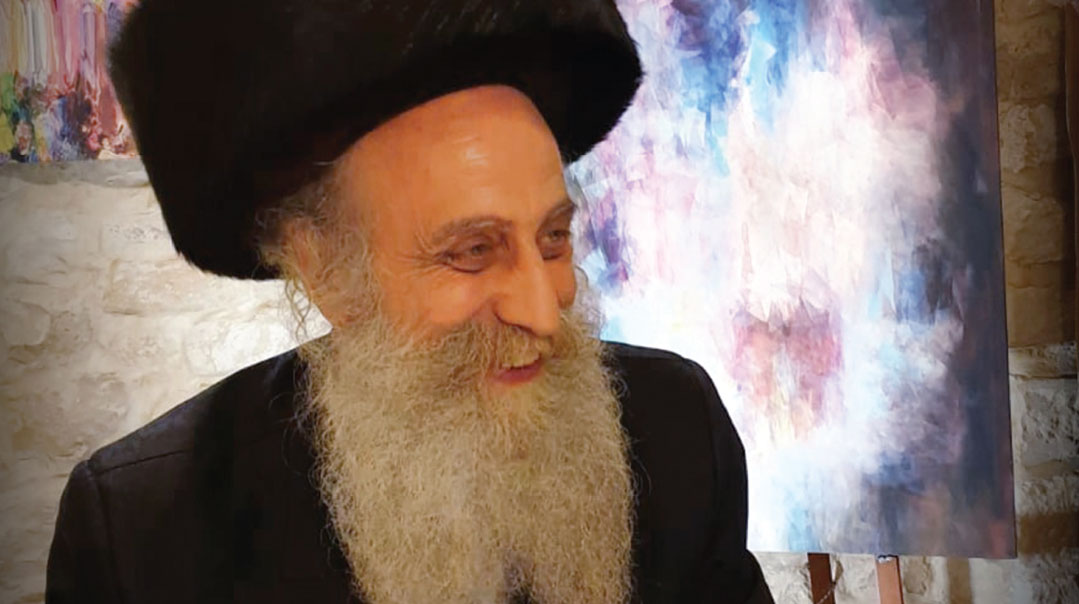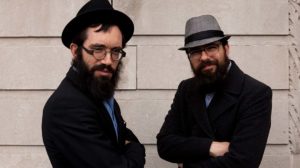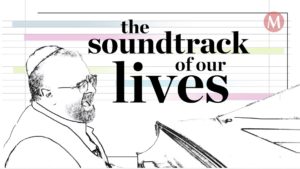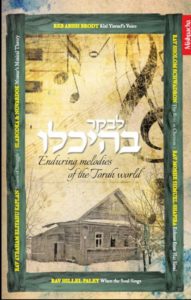With a Broad Brush

At first glance, they’re just random splashes of color. But as your eyes adjust, you might find some surprising images of Yoel Turgeman’s inner world

"What do you see?” asks artist Yoel Turgeman, as I slowly advance through the giant canvases that make up Turgeman’s gallery in Tzfat’s artists’ quarter. What do I see? It’s a little awkward to admit, but mostly just random splashes of color. Still, these are the masterstrokes of a great artist. So great, that I can’t even figure out what he’s created.
“Try to look deeper,” he says encouragingly, and I’m glad he’s not insulted. I sharpen my gaze, continuing to stare at the various shades of blue, shifting my eyes to brown hues and glimmering sparks, and then suddenly, emerging out of this chaotic mass of color, I see it — a man standing in prayer. A deeper look and he seems to be leaning on a staff for support.
Before I can answer, Turgeman is talking again. “Now,” he says, “you are beginning to listen to your neshamah. You’re no longer looking at it only with your intellectual understanding. You broke through the constraints of logic, and that’s how you grasped it. I’ll tell you the truth, the ones who appreciate my paintings most are children under ten or people over seventy-five. Their vision is pure — the young ones because it hasn’t yet been corrupted, and the older ones because they’ve lived long enough to know that what you see at first glance is not necessarily reality.”
Yoel Turgeman, who splits his day between painting and learning Torah, recently completed his 613th painting, (“my taryag picture”), and while the world record holder was Palbo Picasso (he created an estimated 13,500 paintings), it might be a record for a living artist. Yet if you’re expecting to see a gallery full of pastorals or portraits, you’re missing his secret. In maybe ten percent of his works, you can say definitively “that’s a leaf,” or “that’s a flower.” All the other paintings are streaks of color that leave an open window for each person’s unique interpretation.
French-born Turgeman, 59, was a talmid of Rav Chaim Chaikin, the rosh yeshivah in Aix-les-Bains and a primary disciple of the Chofetz Chaim. But although he had a “litvish” Torah education, he’s a spiritual mix. He comes from a line of illustrious Moroccan rabbanim — his grandfather was Rav Moshe Turgeman, the rebbi of the Baba Sali.
A talmid chacham who also serves as an Education Ministry supervisor and consultant for art education in various institutions, Turgeman says his inspiration comes primarily from Torah and an emunah connection, and that’s why, when he was invited to give art courses in the chareidi sector, he made it clear that he wouldn’t be teaching the conventional discipline that emerged in the churches of the Renaissance era. Instead, he wrote his own syllabus, in order, he says, “to return to the roots of Jewish art.”
“Who is a true artist? It’s a person who stands and prays to HaKadosh Baruch Hu,” he says. “In the non-Jewish world, they put the artist on a pedestal to turn him into some heroic figure, but a Jewish artist understands that he’s only a conduit through which art flows into the world from Hashem.”
Maybe that’s the reason Turgeman never reveals the meaning of his paintings immediately, but instead gives people time to identify it on their own. “What will it help them to hear my ego talking?” he explains. “I want them to hear their own thoughts. Maybe that’s why every person ultimately sees in my paintings simply… himself.”
DREAMING OF JERUSALEM
One winter day a few years ago, Turgeman and his wife went to visit the grave of the Zvehiller Rebbe, whose burial place in the small Sheik Bader cemetery overlooking the city and near the Knesset is considered to be a segulah for all types of salvations.
“We arrived on Erev Shabbos, and it was snowing. It was freezing, but amazing. We saw with our own eyes how nine kabin of beauty descended on Jerusalem with the snow.
“Jerusalem is a city of light,” he adds. “I have some friends who are photographers, and they say that in Jerusalem they rarely have to use the flash on their cameras, because the city has its own generated light. That’s also why the snow suits it so well, because snow isn’t actually white — it’s transparent and reflects light. It was fascinating to see the center of the world in such a way — mirroring and illuminating, reflecting light and being reflected.”
I ask him about the forms and silhouettes in the picture.
“Forms?” he asks and then smiles. “The forms are created by themselves. I never create forms — the observer is the one who discovers them. Apparently your inner world discovered some meaningful shapes. Sometimes before I go to bed at night, I decide to add another stroke of color to the painting, and when I wake, I discover that the sun’s rays have altered the color and given it intensity and shade. Like I said, I hold the paintbrush, but I don’t control it.”
Finally, a painting that I can easily identify. It’s obviously a shofar. But of course, there’s more to the story.
“Several years ago,” Turgeman recounts, “I was invited to an exhibition arranged for Hadassah Women from Canada. I was sitting to the side, when I saw an elderly couple standing and staring at this painting, rooted to the spot. When I went over to them, the woman said, ‘We’re thinking to buy this painting.’ I answered that I was honored, and it was clear to me that what attracted them was the shofar. I guessed that among all these abstract paintings, they were looking for something that tangibly symbolized Judaism. Except that in the course of the conversation I learned that the husband wasn’t even Jewish, and the wife had never heard about Shabbos. The woman explained, ‘We saw many stunning paintings in this exhibition, but when we passed this one, I felt my whole body tremble.’
“I assumed she had some memory of Rosh Hashanah, and said, ‘I see the shofar touched something in you.’ She looked up at me, perplexed. ‘Shofar? What’s a shofar?’ And in that minute, I understood the meaning of the pasuk, ‘They saw the voices.’ Because what I tried to create in the first place was the voice of the shofar. I didn’t paint the shofar itself, but the blast that’s echoing from the beginning of the world. I painted the essence of the shofar, not its outward shape. And this woman, who had never heard of a shofar, saw it.”
HEALING IN THE WOODS
“For man is a tree of the field.” While every classic commentator has something to say about this verse, Turgeman says it expresses his inner identity.
“About seven years ago, I went through a very challenging period, when my entire muscular system crashed, accompanied by chronic fatigue and excruciating pain. The doctors gave me little hope, saying I’d have to bear the pain my entire life. Feeling totally powerless, I decided to go to the forest to relax and seek healing there. For several days I prayed and spoke to HaKadosh Baruch Hu. The prayers surely helped, and the pain gradually died down. But it didn’t really surprise me, because we know that it’s the power of the Torah that gives us life, health, and vitality. When I awakened and reconnected with my neshamah, my body cured itself.”
And that’s also where this painting was born, Turgeman explains. “It’s made up completely of points of light and the fresh green shades of vegetation, of a tree and etches and motion. If you look closely at the tree, you’ll see a man inside it standing in prayer — that’s real Jewish art.”
The original painting was sold at a tzedakah benefit for $30,000.
City of Secrets
Try examining this picture and see if you can guess which city is hiding in it. Abandon logic and access your imagination. If you noticed the eye standing out in the middle of the painting, you probably understand.
Did you recognize Tzfat? Turgeman chose to paint his native city without the lights and alleys, without holy cemeteries and tombstones. He worked on the painting over two years. “Tzfat is not a city you can capture with a camera,” he explains. “It’s a city you have to be in: breath, study, observe, and live. In Tzfat there are elements that are apparent, and elements that are hidden. Five hundred years ago, the people who lived here wrote the rules we live by: halachah, drash, and sod.
“Not so long ago,” Turgeman continues, “a Jew I met stood in front of this painting. He didn’t know what Tzfat was or understand its essence, but he started crying and told me that the painting reminded him of his bar mitzvah 40 years ago. He kept repeating, ‘Here I am in front of an abstract painting, yet I feel for the first time that I have a soul.’”
He shares another story, about a Brazilian woman who’d been raised as a devout Catholic. At one point she visited Israel, and when she encountered Turgeman’s painting in a Tzfat gallery, something stirred in her heart.
“She wanted to learn more about the painting, and that’s how we started a correspondence,” Turgeman remembers. “One day she wrote me that her grandmother was ill and requested that I go to the Kotel and pray for her. After consulting a rav, I went and prayed. Several days later she wrote back that when she told her grandmother that a Jew had prayed for her, the grandmother revealed the secret of her life: She was Jewish, the fourth generation of Jewish women who had married Christians. The grandmother passed away, but the woman felt strongly drawn towards religion, and began lighting Shabbos candles a week later.
Melody of Life
Turgeman’s other claim to fame is that he’s the father of a young, talented chazzan, Reb Yisrael Nachman, who performs frequently across Europe and serves as chazzan at the Tel Aviv International Synagogue.
“I remember my son’s first concert,” says Turgeman. “We were in Poland together with some Holocaust survivors. We stayed in a hotel in Cracow, where he first ascended the public stage, with the sole accompaniment of a piano. He really touched the crowd emotionally, and that’s what spurred me to create this painting of the pianist.”
One day he noticed a tourist standing in front of the picture and moving his hands like a conductor. After a few minutes, the man told him, “This is an amazing symphony.”
It turned out that he was director of a large museum in Boston. This painting captivated his heart because he had recently installed a piano in the museum, which instead of emitting musical notes, flashes a variety of colors when its keys are pressed. There are only two others like it in the world — people press on the keys and see their music on the walls. “He told me,” Turgeman recounts, “that if I wanted, he could take a piece of paper and write down the precise melody that was playing in the painting.”
It’s possible that you’re seeing something else in the painting — the song of life. “People have told me they see a monitor hanging above the head of a patient, sometimes beeping, sometimes ticking, sometimes silent — it’s the melody of life.”
Fallen Fronds
To get inspiration, says Turgeman, you don’t have to search very far. It’s enough to look at a grain of sand or a little leaf.
“You look at the leaf and think in simple terms about how it grew and how it got where it was,” he says. “You remember that it was connected to the bough by a hundredth of a millimeter, and then the question arises how the bough grew out of the tree, and where its roots grew from. And then you discover that the roots are an exact replica of the branches underground. And how does the rain nurture them? From the clouds, some of which weigh millions of tons, which are carried by powerful winds from one end of the earth to another. You don’t have to travel to Niagara Falls or the Himalayas, it’s enough to just open your eyes and look around.”
But Turgeman says he didn’t paint this picture after contemplating a little leaf. In fact, he never paints in moments of meditation. “During hitbodedut I allow myself only to feel and sense. I also carry a camera with macro lenses and take pictures of details. For this painting, for instance, I photographed 300 different leaves that had fallen to the ground. A year later as I was randomly flipping through the photographs, I was suddenly overwhelmed by the same emotions I felt back there on the forest floor, and at that point I picked up the brush and started to paint.”
Water Colors
“The ‘rain’ painting is just something I felt inside,” says Turgeman. “I was in Sacher Park one day in the fall, and although the weather started out warm as usual, all of a sudden the first rains of the season began.” While others fled for cover, Turgeman used it as an opportunity to observe the rain from up close — until he was drenched.
“We always think of the rain as coming down to the ground from the heavens,” he says, “but as I stood there, I noticed how the grass, the plants, even inanimate objects seemed to stand up and straighten out to meet the rain. That is, the rain didn’t just descend, it also caused the earth to ascend. If you look closely, you’ll notice that you can’t tell whether the rain drops are going up or down. Also, there’s a curtain of fog on one hand, but at the same time the colors are striking, because when it rains, everything looks brighter, like the world has been freshly-painted.”
Layers of Light
One masterpiece here is a painting selected for auction at Christie’s, the world’s largest auction house, to be used as the cover of the booklet presenting the items for auction.
Turgeman painted this work as a series of optical illusions. It looks like pages of an open book, or perhaps newspaper clippings. But whatever its intention, it’s impossible to precisely identify the various shades — because 150 layers of color, most of them almost completely transparent, are what give it its unique aspect.
At the time Turgeman painted it he didn’t know that he was participating in a novel psychological experiment. “It happened after a group of senior psychologists came to me and one of them bought the painting,” says Turgeman. The man then sent the following email: “I hung the portrait in the living room in my house near Miami. Aside from the painting there was only one other object in the room, an Italian-leather sofa. Every day I would sit on the sofa and look at the painting for half an hour, while meditating on various things in my life. I can’t explain why, but gradually I began feeling much better both physically and mentally; anxieties disappeared, I slept better, and even more — you remember that I came to you with crutches? I don’t need them anymore.’”
Turgeman doesn’t quite understand it himself — it’s something about the shapes and colors on the pages that connects between the right and left hemispheres of the brain, giving the mind a chance to heal itself.
Balancing Act
“There is no more paradoxical combination than fire and water, which can’t mix,” says Turgeman. So why did he choose this motif for his “Fire and Water” painting? “I connected them by bringing in a third element — a wave,” he explains. “A wave is movement, a wave is harmony, and that’s exactly the balance that’s necessary between human functions. We need the fire of enthusiasm, but we also need water, calmness, and consistency. We always have to find the right balance.”
Turgeman says he was inspired by a book called Fire and Water by Rav Nosson of Breslov, Rebbe Nachman’s prized disciple. “After reading the book,” Turgeman explains, “I asked myself how it was possible that Rav Nosson, who had status, money, and friends, left everything to follow his teacher, publishing his works and igniting the fire of his teachings in the young generation of chassidim, while himself living in constant danger of being deported to Siberia. The more I read about him, the more I realized that the secret of his life was fire and water. Every day he relit anew the fire and enthusiasm within his heart, and that’s how the struggle became sweet to him — and the waves he encountered throughout his life allowed him to do the impossible.”
Infinite Sparks
Turgeman ushers me toward the door and asks me to step outside the gallery. It’s already dark outside, but he insists on leading me to an even darker area, with no lights, and then asks: “Try and count how many stars you can see.” I raise my eyes, and at first see only a small smattering. But the artist won’t give up: “Wait half a minute and then look again.” And after a minute he instructs: “Wait another minute.” After six minutes I discover something amazing. The smattering of stars I saw have turned into an uncountable mass.
“That’s the light of the Jewish nation,” he says. “Because for a Jew the whole day revolves around light. It’s 24 hours of light, from the moment when he can daven Maariv, until the middle of the night for Tikkun Chatzos when the light is blue on the horizon, then when the light is a blinding sun, and finally again at shkiah.”
He leads me back to the gallery and, with this new perspective, I now look at the golden picture, called “Sparks.” Maybe there’s a human form in there; some people recognize a face.
“It’s definitely multilayered,” says Turgeman, “but to me, it’s clear that this is the story of Creation, the antithesis of a world that developed on its own. Today scientists agree that the atom is not the smallest component of matter, but that there are even smaller components called photons. And what is the photon made of? A combination of points of light that are constantly renewing themselves every moment. As Jews, we know that Hashem renews the world every day — He is the true Artist of all creation.”
(Originally featured in Mishpacha, Issue 777)
Oops! We could not locate your form.












